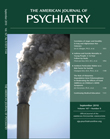Response to Kellner et al. Letter
To the Editor: We appreciate the opportunity to respond to Kellner et al.'s comments underscoring the clinical urgency associated with the treatment of acute catatonia and important aspects of ECT stimulus dosing in this syndrome.
Our stimulus setting for the initial treatment took into account the recommendations of the half-age formula but also accounted for other factors that may have affected seizure threshold. Our patient's age and gender may have reduced her seizure threshold, while recent benzodiazepine treatment, possible dehydration, and use of bilateral electrode placement may have raised it. These complexities preclude a precise dosage determination. Furthermore, Kellner et al.'s suggestion that a more aggressive (suprathreshold) stimulus would have produced a more therapeutic seizure reflects research relevant to unilateral ECT treatment (1). There is no evidence that suprathreshold bilateral ECT yields a more rapid or robust clinical response. The suggestion of en bloc ECT in this setting is interesting but not one we would currently endorse. The evidence base for this treatment approach is anecdotal and includes cases of neuroleptic malignant syndrome. The only prospective, randomized comparison of single- and double-ECT stimulations studied treatment-resistant depressed populations (2). Indeed, catatonic patients are often exquisitely responsive to ECT and may even show response after one treatment (3), making the initial administration of multiple seizures unnecessarily aggressive.
A further variation in treatment not mentioned by Kellner et al., the application of daily rather than thrice weekly treatments for the acutely ill woman, could not be undertaken due to cardiac complications associated with the initial treatment. Interdisciplinary re-evaluation and further consent discussion were necessary before ECT treatment could recommence. The most important factor preventing a more rapid intervention was the legal hurdle of obtaining emergency guardianship. The process took 20 days and might have been further prolonged if an involved, reliable caregiver had not been available. Aggressive legal action and a responsive judicial system are often the most crucial aspects of urgent care.
1. : Titrated moderately suprathreshold vs fixed high-dose right unilateral electroconvulsive therapy. Arch Gen Psychiatry 2000; 57:438–444Crossref, Medline, Google Scholar
2. : An efficacy study of single versus double seizure induction with ECT in major depression. J Clin Psychiatry 1990; 512:473–478Google Scholar
3. : Electroconvulsive Therapy, 3rd ed. New York, Oxford University Press, 1997Google Scholar



